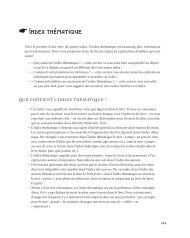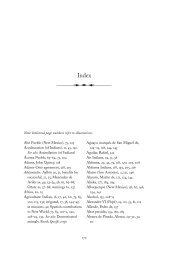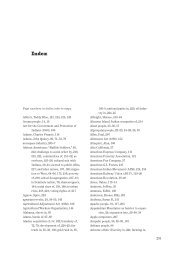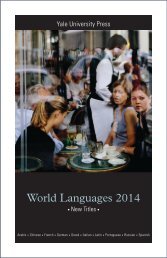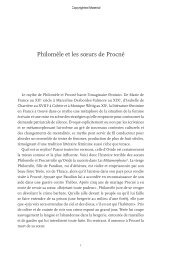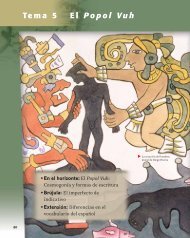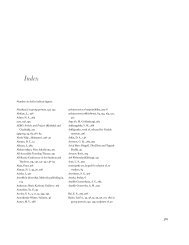Create successful ePaper yourself
Turn your PDF publications into a flip-book with our unique Google optimized e-Paper software.
French in Action, 3rd Ed. Textbook Part 1<br />
<strong>Contents</strong><br />
Preface to the Third Edition | vii<br />
Acknowledgments | ix<br />
1 Introduction | 1<br />
2 Genèse I | 9<br />
3 Genèse II | 18<br />
4 Genèse III | 26<br />
5 Familles | 34<br />
6 Portraits I | 42<br />
7 Portraits II | 50<br />
8 Généalogie | 58<br />
9 Vacances en Bretagne I | 68<br />
10 Vacances en Bretagne II | 80<br />
11 Rencontres I | 89<br />
12 Rencontres II | 100<br />
13 Rencontres III | 113<br />
14 Entrée en matière I | 129<br />
15 Entrée en matière II | 141<br />
16 Entrée en matière III | 156<br />
17 Il n’y a pas de sot métier I | 168<br />
18 Il n’y a pas de sot métier II | 180<br />
19 Attention: Ecoles I | 194<br />
20 Attention: Ecoles II | 208<br />
21 Attention: Ecoles III | 220<br />
22 A la recherche d’une<br />
invitation I | 230<br />
23 A la recherche d’une<br />
invitation II | 242<br />
24 Nourritures terrestres I | 256<br />
25 Nourritures terrestres II | 273<br />
26 Nourritures terrestres III | 285<br />
Abréviations | A-1<br />
Lexique | A-3<br />
Credits | A-61<br />
Copyright © 1987, 1994, 2013 by Pierre Capretz and Barry Lydgate.
French in Action, 3rd Ed. Textbook Part 1<br />
Preface to the Third Edition<br />
The third edition of French in Action<br />
has been designed to allow twentyfirst-century<br />
learners to connect<br />
fully with the linguistic and cultural<br />
riches of the video programs<br />
that are at the heart of the course.<br />
Those programs, originally broadcast<br />
on PBS stations and distributed<br />
on videocassette, afforded teachers<br />
an uncommonly rich access to<br />
authentic materials for teaching<br />
French language and culture. They<br />
were also unique in giving learners<br />
a window onto the look and feel of<br />
French culture through the story of<br />
Mireille Belleau and Robert Taylor<br />
and a cast of characters that one<br />
reviewer has called “so incredibly<br />
good-looking that you really, really<br />
want to be able to talk to them. It is<br />
learning by desire.” 1<br />
A decade later, much in France<br />
and the French-speaking world had<br />
changed, and a much-enhanced<br />
second edition of the ancillary<br />
materials—textbook, workbooks,<br />
audio program—was published to<br />
reflect the changes that had taken<br />
place since the first edition.<br />
Since then, of course, France<br />
and the French-speaking world<br />
have continued to evolve, as have<br />
technology, global awareness,<br />
and multicultural understanding.<br />
Hence this third edition, which<br />
1. Robert Lloyd, “ ‘French in Action’:<br />
Now on an Internet near you.”<br />
http://latimesblogs.latimes.com/<br />
showtracker/2011/11/french-in-action-<br />
.html.<br />
adds a wide variety of updated<br />
and contemporary documents that<br />
open new perspectives onto today’s<br />
France, and onto Francophone<br />
cultures and France’s place in the<br />
European Union in an increasingly<br />
interconnected world. Among other<br />
innovations in the new edition,<br />
instructors, their students, and<br />
independent learners will find:<br />
• more than two hundred new<br />
and revised documents (up-to-date<br />
sociological and demographic data;<br />
illustrations and cartoons; literary<br />
texts, and biographical information<br />
about their creators) whose variety<br />
and cultural appeal will stimulate<br />
discussion and help develop skills<br />
in reading and writing.<br />
• a wholly new feature, Le Journal<br />
de Marie-Laure, by the now grownup<br />
but still beguiling youngest<br />
daughter of the Belleau family who<br />
observes and comments—in her<br />
youthful idiom and with her signature<br />
impish humor—on changes in<br />
culture, politics, and technology in<br />
the world since the earlier editions.<br />
Many passages from the diary are<br />
followed by selected tweets from<br />
Marie-Laure’s Twitter account.<br />
• a wide selection of French<br />
popular songs, with texts printed<br />
in the textbook and original music<br />
reproduced in the audio program.<br />
• a fresh graphic design for both<br />
the textbook and workbooks. Most<br />
of the roughly one thousand images<br />
in the textbook are now in full<br />
color, and a large percentage are<br />
entirely new.<br />
Most of the new documents and<br />
Le Journal de Marie-Laure are supported<br />
by activities designed to train<br />
learners to uncover meaning by<br />
read ing contextually. A generous<br />
array of accompanying exercises<br />
helps refine learners’ skills at communicating<br />
effectively in written<br />
French. The instructor’s guide<br />
and student study guides are now<br />
online (http://yalebooks.com/<br />
fiaguides).<br />
The fifty-two lessons of French<br />
in Action provide the equivalent of<br />
two years of college-level French—<br />
elementary and intermediate—<br />
when programmed at the rate of<br />
thirteen lessons per semester. The<br />
course has also been used successfully<br />
at the secondary level, where<br />
if necessary it can be programmed<br />
at fewer lessons per term.<br />
For Learners:<br />
How to Use<br />
This Course<br />
The text of each lesson from 2 to<br />
52 in this textbook introduces<br />
the successive installments of an<br />
ongoing story that is structured<br />
to foster progressive assimilation<br />
of the French language. In lessons<br />
2–8 you will meet the characters<br />
and become familiar with the basic<br />
situation from which this long saga<br />
will emerge. As the story develops<br />
and becomes more complex, the<br />
Copyright © 1987, 1994, 2013 by Pierre Capretz and Barry Lydgate.
viii<br />
preface to the Third Edition<br />
French in Action, 3rd Ed. Textbook Part 1<br />
grammatical, lexical, and cultural<br />
elements you will encounter become<br />
richer and more varied, and<br />
your ability to understand them<br />
and use them in actual communication<br />
will expand concurrently.<br />
The video programs that accompany<br />
this text contain the story of<br />
the two lead characters, Robert and<br />
Mireille, in fifty-one half-hour episodes.<br />
Users have found that they<br />
learn most successfully when they<br />
watch the video program corresponding<br />
to each lesson before they<br />
read the text of that lesson. Viewing<br />
the story in real time will help you<br />
follow the plot and understand<br />
what is going on in every situation.<br />
Each video program includes a<br />
section designed to help you figure<br />
out the meaning of key words in<br />
the story, since no English is used.<br />
You will learn most comfortably<br />
and effectively if you view this enabling<br />
section before turning to the<br />
corresponding lesson in the workbooks<br />
that accompany the text.<br />
The audio program for this<br />
course is designed to be used<br />
concurrently with the textbook and<br />
workbooks, at home, in a language<br />
laboratory, or online. The majority<br />
of activities in the workbooks<br />
require use of the audio recordings.<br />
To access the updated audio program,<br />
go to yalebooks.com/fia.<br />
A study guide in English is also<br />
available online. It provides stepby-step<br />
directions for the effective<br />
use of all the components of this<br />
course, a statement of the main objectives<br />
of each lesson, a summary<br />
of each episode of the story, cultural<br />
notes, and additional assistance<br />
with the various tasks presented in<br />
the workbooks. The study guide,<br />
while indispensable for distance or<br />
independent learners, is optional<br />
for on-campus students.<br />
Finally, you should be sure to<br />
read Lesson 1, Introduction (in<br />
English) before you begin following<br />
the story of Mireille and Robert<br />
and before working with the print,<br />
video, and audio materials of the<br />
course. The textbook, workbooks,<br />
video programs, and audio programs<br />
are all elements of a single,<br />
integrated system. Lesson 1 is your<br />
guide to using them together.<br />
Copyright © 1987, 1994, 2013 by Pierre Capretz and Barry Lydgate.
L e ç o n<br />
French in Action, 3rd Ed. Textbook Part 1<br />
1 Introduction<br />
Welcome to French in Action!<br />
Before you enter the world of<br />
French language and culture and<br />
meet the French-speaking men and<br />
women whose activities form the<br />
plot of our story, before you watch<br />
the video programs, listen to the<br />
audio recordings, and plunge into<br />
the workbook and this textbook,<br />
take a moment to read the remarks<br />
that follow. They explain the goals<br />
of the course, its methods and<br />
components, and what we believe<br />
its value will be to you as a learner.<br />
W hy French?<br />
There are more than four thousand<br />
languages spoken on this planet.<br />
You are lucky enough to be a speaker<br />
of English, the world’s leading<br />
language. You already have access<br />
to millions of speakers in hundreds<br />
of countries, to the thoughts and<br />
deeds of thousands of writers over<br />
the centuries. So why learn French?<br />
The first and probably most<br />
important reason is that in a fastshrinking<br />
world, French gives you<br />
access to a wide variety of peoples<br />
and cultures. More than 200 million<br />
people speak French worldwide.<br />
The Francophone (Frenchspeaking)<br />
world includes some fifty<br />
countries across five continents; in<br />
thirty-two of them French is the<br />
first or second official language,<br />
and in many more it is widely<br />
spoken in daily life. French is the<br />
principal language of France, of<br />
course, but it is also one of the official<br />
languages of Belgium, Switzerland,<br />
and Canada. It is the common<br />
language of several countries in<br />
the Caribbean (Haiti, Guadeloupe,<br />
Martinique, Guyana) and in Africa<br />
(Algeria, Tunisia, Morocco, Senegal,<br />
Mauritania, Chad, Togo, the Democratic<br />
Republic of Congo, and the<br />
Ivory Coast, to name only a few),<br />
and it is spoken extensively in the<br />
Middle East (Lebanon and Egypt).<br />
Along with English, French is one<br />
of the world’s international languages.<br />
If you have a United States<br />
passport, notice the two languages<br />
in which it is written: English and<br />
French. Wherever you go in the<br />
world, you will find educated men<br />
and women who speak French as a<br />
second or third language. A person<br />
who knows English and French is<br />
equipped to thrive in almost any<br />
country on earth.<br />
Knowing French brings with<br />
it a new way of seeing, of listen -<br />
ing, and of thinking. Much of the<br />
creative thinking that has shaped<br />
the Western tradition has been<br />
done in French. French opens<br />
the doors to the works and words<br />
of many of the world’s greatest<br />
philosophers, scientists, musicians,<br />
painters, and writers. To read them<br />
in their own language is to grasp<br />
subtleties and beauties that too<br />
Copyright © 1987, 1994, 2013 by Pierre Capretz and Barry Lydgate.
2 leçon 1<br />
often disappear in translation. A<br />
number of great French writers<br />
are represented in French in Action:<br />
Jean de La Fontaine, Victor Hugo,<br />
Simone de Beauvoir, Jean-Paul<br />
Sartre, Marguerite Yourcenar, and<br />
many others. To encounter them<br />
and other French-speaking authors<br />
in their own language is to enter<br />
sympathetically into different ways<br />
of constructing and understanding<br />
the world, since the language itself<br />
mirrors perspectives on reality that<br />
are specific to the cultures that use<br />
it.<br />
Some people are interested in<br />
learning French because of the long<br />
and close historical ties that exist<br />
between France and the United<br />
States. In fact, no nation other than<br />
England has played a more decisive<br />
role in the making of America.<br />
(Were you aware that the first Europeans<br />
to settle in North America<br />
were French Huguenots who founded<br />
a colony in Florida in 1564?)<br />
French explorers like Cartier,<br />
Champlain, Marquette, and La Salle<br />
led expeditions through Canada<br />
and the Great Lakes region, and<br />
down the Mississippi River; and<br />
French colonists settled vast areas<br />
of the North American continent.<br />
You might be one of the 9 million<br />
Americans of French descent, or<br />
live in one of the cities founded by<br />
French people: Detroit, Michigan;<br />
Fond du Lac, Wisconsin; Terre<br />
Haute, Indiana; St. Louis, Missouri;<br />
French in Action, 3rd Ed. Textbook Part 1<br />
Baton Rouge, Louisiana; or Paris,<br />
Texas, among many others. French<br />
soldiers fought alongside the colonists<br />
in the Revolutionary War, and<br />
the treaty that ended that war was<br />
signed in Paris. Alexis de Tocqueville<br />
was one of the first and most<br />
perspicacious commentators on the<br />
new nation; his Democracy in America<br />
is central to the study of American<br />
political history and one of the<br />
wisest books ever written about the<br />
United States. A French architect,<br />
Pierre L’Enfant, designed the layout<br />
of Washington, D.C. The Statue<br />
of Liberty, perhaps the foremost<br />
symbol of the United States, was a<br />
gift from France. And the French<br />
and Americans fought, and died,<br />
side by side in World Wars I and II.<br />
(More Americans are buried in<br />
France than in any country except<br />
the United States.)<br />
Many people have practical or<br />
professional reasons for wanting to<br />
learn French. They may be preparing<br />
for a career in international<br />
law or commerce (a French word),<br />
in the diplomatic corps (another<br />
French word), or in the world<br />
of fashion. France is the world’s<br />
sixth-largest economy, and it is at<br />
the geographical heart of Europe,<br />
which is the world’s largest market.<br />
Careers in business, science, technology,<br />
aerospace, and medicine<br />
routinely involve research, communication,<br />
and international collaboration<br />
in French. The smart card,<br />
fiber optics, HDTV, and touch-tone<br />
technology are all French inventions.<br />
And France’s TGV (train à<br />
grande vitesse) is the fastest train in<br />
the world.<br />
From French<br />
to English<br />
(and back)<br />
It has been said that a person who<br />
does not know a foreign language<br />
can never truly know his or her<br />
own. Whatever your purpose,<br />
studying French will enhance your<br />
knowledge and control of English.<br />
The two languages, in fact, have<br />
much in common, and you may be<br />
surprised by the amount of French<br />
you already speak. If you have<br />
ever said “Very chic!” to a friend<br />
whose new clothes you admire, you<br />
were speaking French. If you have<br />
ever been on the receiving end<br />
of a barbed criticism and retorted<br />
with a gallant “Touché!” that, too,<br />
is French. How often have you<br />
wished someone “Bon voyage!” or<br />
“Bon appétit!”? (With French, you<br />
always have le mot juste at the ready.)<br />
Every aspect of English has felt the<br />
French influence, from soldiery<br />
(“curfew” = couvre-feu) to squaredancing<br />
(“do-si-do” = dos-à-dos).<br />
Your native English is full of French<br />
words and expressions; indeed, it<br />
has been claimed, not entirely in<br />
jest, that 60 percent of the English<br />
language is nothing but mispronounced<br />
French. It is a fact that<br />
ever since the Norman Conquest<br />
of Britain in 1066, which led to a<br />
fusion of an earlier form of English<br />
with an earlier form of French,<br />
the two languages have shared<br />
thousands of cognate words, such<br />
as “curious” and curieux, “marriage”<br />
and mariage, not to mention<br />
“French” and français. Some<br />
words even returned to French<br />
after having migrated to English:<br />
the French command form tenez!<br />
Copyright © 1987, 1994, 2013 by Pierre Capretz and Barry Lydgate.
French in Action, 3rd Ed. Textbook Part 1<br />
used to announce a serve in a ball<br />
game involving nets and rackets<br />
appeared in English as “tennis” in<br />
the fifteenth century; the French<br />
repossessed the word in the early<br />
1800s and have been playing le tennis<br />
ever since.<br />
Despite these many similarities,<br />
it can sometimes be difficult<br />
to recognize a French word that<br />
has been adopted by English. One<br />
reason this is true is that English<br />
speakers have habits of pronunciation<br />
that are quite different from<br />
those of the French. For instance,<br />
speakers of French tend to say each<br />
syllable of a word with the same<br />
intensity. Speakers of English, on<br />
the other hand, tend to stress one<br />
syllable—often the first one—and<br />
to skip over the others. So when<br />
French speakers say the word<br />
capitaine, they stress all three syllables<br />
equally: ca-pi-taine. But when<br />
English speakers appropriated this<br />
word they pronounced it in their<br />
own way, stressing the first syllable<br />
so much that the second syllable<br />
disappeared altogether: captain. The<br />
same thing happened to the French<br />
words cabestan (“capstan”), compartiment,<br />
and gouvernement, among many<br />
others.<br />
French words that have crossed<br />
over to English can also be difficult<br />
to recognize because they are<br />
spelled differently. Differences in<br />
spelling often reflect differing habits<br />
of pronunciation, but they are<br />
due as well to the fact that many<br />
French words passed into English<br />
centuries ago and kept their original<br />
spelling in the new language,<br />
while the spelling of the French<br />
originals evolved over time. This is<br />
true, for example, of many words<br />
that now have a circumflex accent<br />
(ˆ). In modern French, the circumflex<br />
replaces an s that appeared in<br />
older forms of these words; in their<br />
English equivalents, that s is still<br />
present:<br />
forest (forêt), haste (hâte), host<br />
(hôte), mast (mât), coast (côte),<br />
beast (bête), feast (fête). . . .<br />
French words ending in -é and -ie<br />
often correspond to English words<br />
ending in y:<br />
cité, éternité, bébé; biologie, calorie,<br />
envie. . . .<br />
Many French words ending in<br />
-eux correspond to English words<br />
ending in -ous:<br />
spacieux, envieux, cérémonieux, curieux,<br />
dangereux. . . .<br />
French words ending in -ier often<br />
correspond to English words ending<br />
in -ar or -iar (familier, particulier)<br />
or to words in -er (papier).<br />
Numerous French words ending<br />
in -e correspond to English words<br />
having no final -e:<br />
leçon 1 3<br />
soupe, classe, adresse, Arabe, architecte,<br />
artiste, cabine, calme, carotte, crabe. . . .<br />
Other analogues:<br />
-iel often corresponds to English<br />
-ial (artificiel, partiel)<br />
-aque to English -ack (attaque)<br />
-ait to English -act or -ect (abstrait,<br />
parfait)<br />
-ice to English -ess (actrice)<br />
-aire to English -ary (anniversaire,<br />
ordinaire, culinaire, contraire, élémentaire)<br />
or -arian (autoritaire)<br />
-ique to English -ic (fantastique,<br />
exotique)<br />
-ret to English -rete (discret, concret)<br />
-ant to English -ating (fascinant)<br />
-re to American English -er (ordre,<br />
théâtre)<br />
-ant to English -ing (amusant,<br />
intéressant)<br />
-eur to English -er (boxeur)<br />
-ment to English -ly (certainement,<br />
complètement, essentiellement, évidemment,<br />
exactement, finalement,<br />
généreusement)<br />
-eur to English -or (conducteur, erreur,<br />
couleur, horreur, honneur)<br />
-é to English -ed (décidé, équipé, fixé,<br />
forcé)<br />
All in all, then, there are many<br />
thousands of French words that<br />
are similar to English words, and<br />
this will streamline to some extent<br />
the process of learning French.<br />
Unfortunately, however, the fact<br />
that a French word and an English<br />
word are similar does not mean<br />
they are the same word; they aren’t.<br />
Nor does it mean they refer to the<br />
same thing; they don’t necessarily.<br />
When you come across a French<br />
word that sounds or looks like<br />
a word in English, you can for a<br />
moment entertain the possibility<br />
that the two are connected and that<br />
the things they refer to have some<br />
feature in common. But beware:<br />
although some English-French<br />
cognates do have essentially the<br />
same meaning (“rapid” and rapide,<br />
for instance), the resemblance of<br />
Copyright © 1987, 1994, 2013 by Pierre Capretz and Barry Lydgate.
4 leçon 1<br />
others may be quite distant, merely<br />
superficial, even purely coincidental.<br />
In fact, the majority of French<br />
words that resemble English words<br />
differ in meaning. “An injury”<br />
is a wound, for instance, but une<br />
injure is an insult. The French verb<br />
prétendre refers to making a claim<br />
or an assertion, not indulging in<br />
make-believe. (The English words<br />
“pretense” and “pretentious” are<br />
closer to the French original; a<br />
pretender to the throne is one<br />
who lays a claim, not someone<br />
who’s play-acting.) The patron of an<br />
establishment is its owner, never its<br />
customer. The verb demander is used<br />
to make a simple request, not just<br />
issue an ultimatum. Your anniversaire<br />
falls on the date of your birth, not<br />
the date of your marriage. And so<br />
on and so forth.<br />
The result of all this is that you<br />
must not assume that a French<br />
word means the same thing as an<br />
English word because they happen<br />
to resemble each other. You may<br />
hypothesize—very cautiously—that<br />
there might be some relationship<br />
between their meanings, but you<br />
must then check your hypothesis<br />
by studying the context in which<br />
the word is used. Only the context<br />
can give you a valid insight into<br />
the function of a word in a given<br />
French in Action, 3rd Ed. Textbook Part 1<br />
situation. In this course we will<br />
concentrate a great deal on the<br />
situations and contexts in which<br />
words appear; they are the real keys<br />
to meaning.<br />
How to Learn<br />
French<br />
Think for a moment about how a<br />
person learns a second language.<br />
One means—the oldest known to<br />
history—is total immersion. This<br />
is the “sink or swim” process,<br />
whereby immigrants, explorers, or<br />
students in a foreign country pick<br />
up the language. Without grammar<br />
books, textbooks, audio CDs,<br />
dictionaries, language laboratories,<br />
drill sessions, tutors, or teachers,<br />
people have learned second, third,<br />
or fourth languages from the book<br />
of life and the school of experience.<br />
The incentive is survival—<br />
strong motivation indeed—and<br />
the classroom is the world. That is<br />
one method, but it is neither the<br />
easiest nor the most efficient. In the<br />
sink or swim method, you would<br />
learn what you needed in order to<br />
accomplish the chores of daily life,<br />
catch the drift of conversations,<br />
and make yourself understood. But<br />
you might never pronounce words<br />
properly, or progress beyond the<br />
speech level of a four-year-old, and<br />
you might never learn how to read<br />
anything other than street signs<br />
and labels.<br />
Another method, one you may<br />
have already encountered in school,<br />
is the grammar-translation method,<br />
where you learn endless rules,<br />
memorize verb and noun forms in<br />
specific orders, and translate word<br />
for word from one language to<br />
another. Although this method has<br />
proven useful for languages that are<br />
no longer spoken (Sanskrit, Latin,<br />
classical Greek), it is next to worthless<br />
for learning a living language<br />
in which you must communicate<br />
with other people. When you meet<br />
someone on the street, for instance,<br />
in Paris, Dakar, or Montreal, and<br />
want to carry on a conversation,<br />
you don’t have the time to run<br />
through your verb forms: “Shall I<br />
have lunch? Will you have lunch?<br />
Will he or she have lunch? Shall<br />
we have lunch?” By the time you<br />
Copyright © 1987, 1994, 2013 by Pierre Capretz and Barry Lydgate.
find the phrase you are looking for,<br />
your acquaintance will long since<br />
have left—to go to lunch. In actual<br />
conversations, the grammar book<br />
and the dictionary aren’t much use.<br />
French in Action employs a method<br />
that is almost certainly quite<br />
different from that of any other<br />
language course you may know.<br />
It gives you the advantages of the<br />
immersion method without its<br />
chaos by presenting native speakers<br />
in vivid situations and real<br />
settings. At the same time, this<br />
course structures the way you learn<br />
the language, so that you can learn<br />
efficiently. We are going to plunge<br />
you into the French language. You<br />
are going to hear more French than<br />
you can possibly remember. At first<br />
you may think you are about to<br />
drown. Relax! You won’t. If in the<br />
beginning you feel confused, that<br />
feeling is perfectly normal and will<br />
pass. Rest assured that thousands<br />
have done what you are setting out<br />
to do. You will learn slowly at first,<br />
and you are not expected to understand<br />
everything. Little by little,<br />
things will become clearer, and<br />
then suddenly your knowledge of<br />
French will expand exponentially.<br />
The method of this course is<br />
to begin with a flood of authentic<br />
French in authentic circumstances.<br />
The lessons are carefully constructed<br />
so that your knowledge<br />
of words, phrases, sentences, and<br />
situations will gradually build and<br />
you will assimilate the language.<br />
For example, in lesson 2, you will<br />
see and hear our heroine meeting<br />
different people on her way to<br />
her Italian class at the Sorbonne.<br />
You will see and hear her greet a<br />
newspaper vendor, several friends,<br />
a professor, and one of her aunts,<br />
and you will learn different greetings.<br />
By the end of the lesson, you<br />
will know how to greet people,<br />
how to ask how they are, how to<br />
say how you are, and how to take<br />
your leave—all in French. From<br />
French in Action, 3rd Ed. Textbook Part 1<br />
lesson 2 on, everything you see and<br />
hear in the course will be entirely<br />
in French.<br />
The Story,<br />
the Diary,<br />
the Tweets<br />
French in Action is more than a traditional<br />
textbook providing grammar,<br />
exercises, and explanations. It is<br />
also a story, a tale of suspense in<br />
fact, and we invite you to follow<br />
the characters as they move<br />
through Paris, other cities, and the<br />
French countryside. Like all good<br />
stories, this one has a heroine, a<br />
Parisian university student whose<br />
name is Mireille Belleau. It has a<br />
hero, an American named Robert<br />
Taylor. The story has sketchy<br />
characters, such as Jean-Pierre, the<br />
pick-up artist, and eccentrics, such<br />
as Hubert de Pinot-Chambrun, the<br />
young nobleman who plays his<br />
aristocratic role to the hilt. It has<br />
leçon 1 5<br />
rivals in romance. It has chases. It<br />
has escapes. And it has a dark, shadowy<br />
character, the Man in Black,<br />
a man of mystery who lurks behind<br />
the scenes, silently and relentlessly<br />
following Mireille and Robert.<br />
In each lesson you will find<br />
an excerpt or excerpts from Le<br />
Journal de Marie-Laure, the diary of<br />
another character of the story,<br />
Mireille’s younger sister. Many of<br />
these excerpts are also followed<br />
by Twitter postings that Marie-<br />
Laure has tweeted. We have chosen<br />
these diary passages and selected<br />
tweets because they are often<br />
funny, because they reveal much<br />
about contemporary France, and<br />
because they are written in the offduty,<br />
colloquial French of a young<br />
person. You may not understand<br />
everything in an excerpt, but if you<br />
try to get the gist of what Marie-<br />
Laure is saying, you will find you<br />
grasp most of it, and you may find<br />
it amusing. (See below, “How to<br />
Proceed,” point 1.)<br />
Above all, keep in mind that this<br />
is a tale we have invented just for<br />
Copyright © 1987, 1994, 2013 by Pierre Capretz and Barry Lydgate.
6 leçon 1<br />
fun. The situations you will see are<br />
authentic, but the plot is actually a<br />
kind of send-up of soap opera. If<br />
you don’t like the story, you will<br />
have the chance to reinvent it, to<br />
play with it, to rewrite it. You will<br />
have repeated opportunities to alter<br />
events, to recombine elements, and<br />
to tell the story in different ways<br />
in class, with a friend, or at home.<br />
All this will be part of the game of<br />
learning French.<br />
Language and<br />
Culture<br />
Even though French in Action is based<br />
on a story, what you hear and see<br />
in the various situations that are<br />
presented is the real thing: you will<br />
encounter living French that has<br />
not been simplified or expurgated,<br />
the same French you might hear<br />
spoken among members of a family,<br />
among friends, on the street,<br />
on the radio, or on television. You<br />
will see and hear real French men<br />
and women, their customs, quirks,<br />
clothes, food, cities, homes. And<br />
you will see them as the French see<br />
themselves.<br />
In the process, you may be startled<br />
by the contrasts between the<br />
world you inhabit and the world<br />
of the French. (Just remember, the<br />
French might be equally startled by<br />
you!) Since ours is a boy-meets-girl<br />
story, one contrast you may notice<br />
is that French behavior is different<br />
from American behavior in the<br />
area of relationships between men<br />
and women. Male-female relationships<br />
are of perennial interest<br />
in all cultures, French culture being<br />
no exception. In every society,<br />
relationships between the sexes<br />
are governed by expectations that<br />
are culturally conditioned. These<br />
expectations are taken for granted<br />
by the members of a society, but<br />
French in Action, 3rd Ed. Textbook Part 1<br />
an outsider unfamiliar with the<br />
society’s cultural framework may<br />
not share its expectations, and may<br />
find the behavior in some way<br />
peculiar or questionable.<br />
The relationships between people<br />
that you will see portrayed in French<br />
in Action reflect cultural assumptions<br />
and notions that are specifically<br />
French. But because these assumptions<br />
are not identical to American<br />
expectations in the same areas, the<br />
behavior they underlie may seem<br />
unfamiliar, even inappropriate.<br />
To take one example: in lesson 11,<br />
Jean-Pierre, the loser, tries to pick<br />
up our heroine, Mireille. In most<br />
cultures, including French culture,<br />
the pick-up artist is considered a<br />
social pest, and indeed Jean-Pierre<br />
is portrayed throughout French in Action<br />
in a negative light, rejected and<br />
rebuffed at every turn as a pathetic<br />
loser. He tries to strike up a conversation<br />
with Mireille, and he ends<br />
up striking out. The put-down<br />
comes from Mireille herself, who<br />
gets rid of him in a way that may<br />
seem to make little sense in terms<br />
of American cultural assumptions<br />
but that is wholly appropriate in the<br />
French cultural system: she totally<br />
ignores him. And it works.<br />
Why does Mireille ignore Jean-<br />
Pierre’s aggressive male behavior<br />
instead of telling him off? Isn’t her<br />
silence a retreat into female passivity?<br />
While observers can disagree<br />
about how much of a threat<br />
Jean-Pierre actually is to Mireille<br />
in this episode, it is important to<br />
understand that her response to<br />
him is appropriate and effective in<br />
terms of her own culture. This is<br />
true in large part because silence<br />
has a very different social function<br />
in France than in the United<br />
States. Sociologists who study<br />
the two cultures point out that<br />
Americans use speech to maintain<br />
strangers at arm’s length (making<br />
small talk about the weather, for<br />
instance), whereas in the French<br />
cultural system the act of speaking<br />
to a stranger suggests the exact<br />
opposite: that the speaker wants to<br />
create a connection. This is particularly<br />
true when the situation<br />
involves physical attraction; from<br />
the point of view of French culture,<br />
a verbal acknowledgment of the<br />
other person’s presence, even in anger,<br />
only sets up a relationship and<br />
encourages further communication.<br />
As a result, Mireille’s silence, which<br />
to American eyes can seem passive,<br />
even acquiescent, is in terms of her<br />
culture the very best way to keep<br />
Jean-Pierre at bay.<br />
One thing to keep in mind, then,<br />
as you explore French in Action is that<br />
the situations and relationships it<br />
portrays take place in the context<br />
of a specific culture. Although it is<br />
natural to want to form an opinion<br />
of the French from an American<br />
point of view, it is also important<br />
to perceive them as much as possible<br />
from their own point of view.<br />
We are different from the French,<br />
and the French are different from<br />
us, and that variance challenges us<br />
to extend our capacity for cultural<br />
understanding and communication.<br />
So vive la différence!<br />
H o w t o<br />
Proceed<br />
A few essential points to remember<br />
as you begin your adventure in<br />
French.<br />
1. As you watch the video<br />
programs and listen to the audio<br />
exercises, there will be no English<br />
translations to give you access to<br />
meaning. Try to catch the general<br />
meaning of the conversations and<br />
situations. Pay close attention to the<br />
story, look at people’s expressions,<br />
get the gist of what they are saying,<br />
latch onto the context. Once you<br />
understand the thrust of a situation,<br />
Copyright © 1987, 1994, 2013 by Pierre Capretz and Barry Lydgate.
the meaning of various phrases will<br />
become clear. Above all, do not try<br />
to retain everything you hear; it’s<br />
not really possible, and not necessary.<br />
Keep guessing, keep hypothesizing,<br />
and soon you will develop<br />
a crucial habit: going for the gist<br />
to make sense of conversations in<br />
which the meaning of some words<br />
will escape you at first.<br />
2. Give priority to what you hear.<br />
Throughout French in Action your<br />
first encounter with both the story<br />
and the exercise materials will be<br />
aural. The point of this is to give<br />
you thorough familiarity with the<br />
sounds of the language without<br />
confusing you by stressing the way<br />
it is written.<br />
The writing systems of French<br />
and English—the use of the Roman<br />
alphabet to indicate different<br />
sounds—are an attempt at representing<br />
spoken language by means<br />
of graphic signs (letters). Unfortunately,<br />
as you have undoubtedly noticed<br />
in English, there is no natural<br />
or logical correspondence between<br />
a letter and a sound that the letter<br />
represents. The system of notation<br />
is arbitrary. Take the word business.<br />
We do not pronounce it bizeeness;<br />
we say it as if it were written bizness.<br />
French in Action, 3rd Ed. Textbook Part 1<br />
Moreover, the correspondence<br />
of sounds and letters is not only<br />
arbitrary, it is unsystematic. George<br />
Bernard Shaw humorously proposed<br />
that the word fish should be<br />
spelled ghoti: gh to represent the<br />
sound /f/ as in enough, o to represent<br />
the sound /i/ as in women, and<br />
ti to represent the sound /ƒ/ as in<br />
nation. If Shaw’s sendup of English<br />
spelling seems farfetched, consider<br />
the different sounds of ough in the<br />
words rough, bough, fought, and though,<br />
or the pronunciation of -ger in singer<br />
and danger.<br />
The way in which letters correspond<br />
to sounds in the French<br />
language is very different from the<br />
way they correspond in English. If<br />
you yield to the temptation to pronounce<br />
French as if it were English,<br />
what comes out of your mouth<br />
will bear very little resemblance to<br />
anything a speaker of French would<br />
recognize. Listen carefully to the<br />
sounds of French and train yourself<br />
to imitate them. When you work<br />
with the audio materials, cultivate<br />
the habit of responding out loud,<br />
as assertively as you can without<br />
bothering others. It’s a kind of<br />
mimicry. As teachers, we are well<br />
aware that students love to mock<br />
their instructors by imitating their<br />
verbal habits. We tell our students<br />
that their French course is the only<br />
course they will ever take where<br />
they are encouraged to make fun of<br />
the professor.<br />
3. Don’t let English into the<br />
picture. We will not use English,<br />
because too often translation<br />
interferes with comprehension.<br />
Translating slows you down and<br />
actually gets in the way of understanding.<br />
And in any case, French<br />
is not just English with different<br />
words. You cannot simply replace a<br />
word in one language with a word<br />
in another. The standard English<br />
translation of fenêtre, for instance,<br />
is “window.” But not all windows<br />
are fenêtres: not car windows<br />
leçon 1 7<br />
(vitres), store windows (vitrines),<br />
stained-glass windows (vitraux), or<br />
airplane windows (hublots), and in<br />
any event the windows of most<br />
French houses open out casementstyle<br />
rather than sliding up and<br />
down like American double-hung<br />
windows. Result: the mechanical<br />
replacement of one word by another<br />
often obliterates the cultural<br />
connotations that are at the heart of<br />
meaning. (If you have ever used a<br />
computer translation program, you<br />
know how hilarious the results can<br />
be.) So the lessons of French in Action<br />
will not give you the meaning in<br />
English of a French word or phrase.<br />
There is a glossary of French words<br />
with English equivalents at the end<br />
of this textbook, but you should use<br />
it only as a last resort, since it gives<br />
you words in isolation, deprived<br />
of their context. We will present<br />
words and phrases in various ways,<br />
in different combinations, and<br />
in different contexts so that you<br />
can arrive at their meanings by<br />
yourself.<br />
To take a specific example, in<br />
lesson 2 you will hear and read the<br />
French phrase “Salut! Comment<br />
vas-tu?” If you were to look up each<br />
word in the dictionary and literally<br />
translate those four words, you<br />
would end up with a totally absurd<br />
sentence: “Salvation! How go you?”<br />
Clearly you will have missed the<br />
point. But listening to that sentence<br />
in context, seeing and hearing one<br />
young person greeting another,<br />
you can easily figure out, without<br />
opening a dictionary, that “Salut!<br />
Comment vas-tu?” corresponds in<br />
meaning and in style to something<br />
like “Hi, how are you?” You can<br />
reach that level of understanding<br />
without ever knowing that the<br />
word vas is a form of the verb aller<br />
and that the verb aller is often used<br />
in French in phrases where English<br />
uses the verb to go or the verb to be.<br />
Let’s take a closer look at how<br />
you can figure out the meaning of<br />
Copyright © 1987, 1994, 2013 by Pierre Capretz and Barry Lydgate.
8 leçon 1<br />
an utterance by paying attention to<br />
the differences among several situations<br />
in which it occurs. In lesson 2<br />
you will encounter a teacher saying,<br />
“Nous allons apprendre le français.”<br />
Since this teacher is uttering<br />
this sentence at the very beginning<br />
of a French course, he must be<br />
indicating what he or you will do.<br />
But you cannot be sure what it is.<br />
Now if you see a young girl looking<br />
at her schoolbook and trying to<br />
do her homework, and if someone<br />
says, “Elle apprend sa leçon,” then<br />
you will notice that the phrase Elle<br />
apprend sa leçon has something in<br />
common with the phrase Nous allons<br />
apprendre le français. You will also see<br />
a similarity between the classroom<br />
situation and the situation of the<br />
little girl doing her homework.<br />
Then when you hear the phrase Il<br />
apprend à nager and see a man copying<br />
the strokes he sees in a swimming<br />
manual, you will notice again<br />
the common element apprend. You<br />
cannot help being struck by the<br />
similarity between the last situation<br />
and the first two. And you should<br />
be beginning to have some notion<br />
of what activity the words apprendre<br />
and apprend refer to. Remember, do<br />
not let English enter into the picture.<br />
Resist the obvious translation.<br />
Associate the French words with<br />
the circumstances in which you<br />
have observed them, rather than<br />
with English words.<br />
4. The activities of listening to<br />
a language, speaking it, reading it,<br />
and writing it all demand active<br />
skills. French in Action will require<br />
your active participation. To learn a<br />
language effectively, you must listen<br />
with full attention, and you must<br />
watch carefully. When you learn a<br />
new language, you are assuming a<br />
new role. Play it to the full! Participate<br />
actively by speaking out with<br />
the characters. When you listen to<br />
the audio exercises or watch the<br />
French in Action, 3rd Ed. Textbook Part 1<br />
video programs, copy what you see<br />
and hear. Copy with the sound of<br />
your voice. Copy with the shape of<br />
your mouth. Copy with your gestures.<br />
In the video lessons and audio<br />
exercises, there are interactive sections<br />
of dialogue where you will be<br />
given time to respond to questions<br />
as if you were one of the characters<br />
in the story. Answer clearly, at<br />
normal volume and tempo. If you<br />
do not have time to respond before<br />
the character speaks, simply speak<br />
along with him or her.<br />
Do not try to invent new expressions,<br />
at least for a while, and above<br />
all don’t think things up in English<br />
and try to translate them into<br />
French. Imitate what you observe.<br />
Use the ready-made sentences<br />
or phrases you hear. You will be<br />
encouraged to recombine these<br />
phrases. Both imitation and recombination<br />
are vitally important. The<br />
object is to be able to respond with<br />
an appropriate utterance in a given<br />
situation, even if it is something<br />
you have heard before and is not at<br />
all ingenious or clever.<br />
Saying “Bonjour!” when you<br />
meet someone and “Au revoir”<br />
when you leave, answering “ça va”<br />
to “Comment vas-tu?” or “Bien,<br />
merci, et vous?” to “Comment<br />
allez-vous?” might not be original<br />
or clever, but it is a big step<br />
forward. To be able to give the<br />
right response at the right time is a<br />
deeply satisfying achievement. Before<br />
long, you will build up enough<br />
vocabulary—and confidence—to<br />
personalize what you say. You<br />
will be able to recombine familiar<br />
elements into new phrases and<br />
sentences for new situations, take<br />
some chances, and say things you<br />
didn’t know you knew how to say.<br />
Have fun! And welcome to a<br />
whole new world!<br />
Using the<br />
Illustrations<br />
As you begin working with this<br />
book, you will discover that in each<br />
lesson the text of the story segment<br />
is accompanied by a variety<br />
of illustrations. Inserted into the<br />
text itself you will see a series of<br />
photographs; these are taken from<br />
the video program and will help<br />
you recognize and remember key<br />
contexts and situations in the story.<br />
In shaded areas next to the text<br />
you will find other images (photographs,<br />
drawings, cartoons) and<br />
written examples of how words<br />
and expressions in the text are<br />
used. Their function is to help you<br />
understand the new material of the<br />
lesson without having to resort to<br />
English. As you read, you should<br />
get into the habit of going back and<br />
forth between text and illustrations,<br />
using the pictures and written<br />
examples to help you hypothesize<br />
about the probable meaning of<br />
words and phrases in the story.<br />
To simplify this process, the<br />
story segment of each lesson has<br />
been divided into numbered sections.<br />
A key word or phrase that is<br />
explained in the shaded area will<br />
be identified by the number of the<br />
section in which it occurs. Quite<br />
often several words from the same<br />
text section are explained; when<br />
this happens, the same section<br />
number is repeated for each.<br />
A caption under each photograph<br />
or drawing contains, in boldface,<br />
the key word or expression associated<br />
with that illustration. Frequently<br />
this caption is followed by<br />
further written examples that show<br />
how the word or phrase can be<br />
used in other, somewhat different<br />
contexts.<br />
Copyright © 1987, 1994, 2013 by Pierre Capretz and Barry Lydgate.



